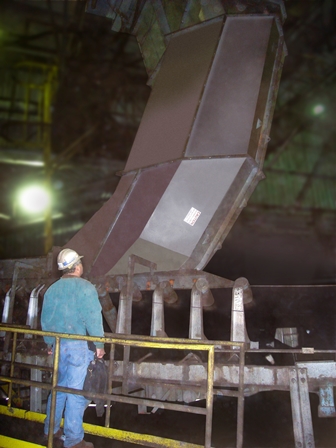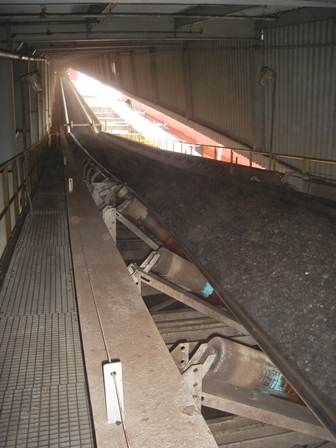Material Backups and Maintenance Reduced At Superior Midwest Energy Terminal
Publicado: June 15th 2012
 [Superior, WI] - A high-volume coal transshipment terminal at the western edge of Lake Superior has eliminated material backups and reduced maintenance -- while extending conveyor belt life -- with custom-engineered transfer chutes. Designed and constructed specifically to address the flow rate and physical characteristics of the terminal’s coal, the chutes have helped to avoid blockage and minimize fugitive material, reducing costly interruptions to clear plugged sections and clean up spills.
[Superior, WI] - A high-volume coal transshipment terminal at the western edge of Lake Superior has eliminated material backups and reduced maintenance -- while extending conveyor belt life -- with custom-engineered transfer chutes. Designed and constructed specifically to address the flow rate and physical characteristics of the terminal’s coal, the chutes have helped to avoid blockage and minimize fugitive material, reducing costly interruptions to clear plugged sections and clean up spills.
One of the challenges for Superior Midwest Energy Terminal was the ambitious loading schedule, which doesn’t afford much opportunity for maintenance and equipment changes. Downtime is limited, with system upgrades handled during the annual January and February maintenance outages. That emphasis on maximizing performance, coupled with the willingness to make investments that will Maintain efficiency, led the terminal to install custom-engineered chutes from Martin Engineering of Neponset, Illinois.
Uptime is Key
Director of Terminal Operations Marshall Elder explained: “We load ships around the clock, so it’s difficult to find time to make changes to our system. We cannot keep vessels—and our customers—waiting for coal while we make changes to our equipment,” he said. The entire transfer chute system was designed and constructed off-site by Martin Engineering, then installed in just four weeks of scheduled downtime.
Superior Midwest Energy Terminal handles approximately 22 million tons of western coal annually. The terminal unloads the unit trains bringing coal from mines in the Powder River Basin and transfers it onto vessels for transport to utility power plants in the U.S. and Canada. Located on a 200-acre site at the mouth of the St. Louis River, the 30 year-old facility has become one of the largest coal handling terminals in the world.
To receive its coal, the terminal unloads more than 1,400 trains from the Burlington Northern and Santa Fe (BNSF) and Union Pacific railway lines each year. “We unload railcars at 5,000 tons per hour, roughly 45 cars an hour, or a full 123-car train in about three hours,” Elder observed. The terminal then loads that coal onto approximately 450 vessels during a 305-day shipping season. Shiploading operations run from late March until mid-January, when ice closes the Wisconsin port.
According to Fred Shusterich, President of Midwest Energy Resources Company (MERC), a DTE Energy Company that owns and operates the terminal, “This is the largest-capacity coal terminal having only one single-car railcar dumper. We put more coal through that single-car dumper than any operation in the world,” he said.  “MERC is a high volume operation,” Shusterich emphasized. “And because of that fact, we make the investments to maintain peak performance levels of our primary coal-handling operations.”
“MERC is a high volume operation,” Shusterich emphasized. “And because of that fact, we make the investments to maintain peak performance levels of our primary coal-handling operations.”
Benefits of Custom-Engineered Chutes
Engineered specifically for the Superior terminal, the Martin® Inertial Flow™ Transfers have minimized previous problems with plugging. “When a chute used to plug up, the material would spill onto the floor and around the conveyor idlers,” Elder explained. “And at 11,500 tons per hour, it doesn’t take long to put a large volume of material outside the chute. That’s a lot of spilled coal, and a lot of man-hours to clean it up. Minimizing the plugging problem has been a very positive aspect of these engineered chutes.”
Inside each chute, a “hood” controls the flow of coal from the discharging conveyor, maintaining a coherent material stream and minimizing induced air. At the bottom, a smooth-transfer loading chute or “spoon” directs the material stream onto the receiving belt at the proper speed and angle, minimizing the impact, material degradation, belt abrasion and expulsion of airborne dust. This reduces abrasive wear on the receiving belt and prevents the air currents that create and drive off airborne dust.
The terminal is anticipating another benefit from the chutes: longer belt life. “That’s one of the key reasons we went to the engineered chutes,” Elder continued. “We anticipate an increase in belt life of approximately 40%, primarily because of the reduced abrasion realized with the new chute design. We anticipate getting seven or eight years of service out of our major belts, or between 175 and 200 million tons of throughput.” Elder said the company monitors the conveyor belt top cover, which ultimately determines when the belts will be replaced.
The performance of the Martin® Inertial Flow™ Transfer is helping Superior Midwest Energy Terminal maintain efficient operations and reliable supply. “We pride ourselves on the volume of material handled and on our dependability,” Shusterich added. “We know it’s more than western coal we are delivering. We are providing power to communities, so we need to be consistently available and operating at peak efficiency. The engineered chutes from Martin Engineering help make that possible.”
“The flow-engineered chute technology provides obvious advantages,” Elder concluded. “I don’t know why any new facility design would incorporate anything else."